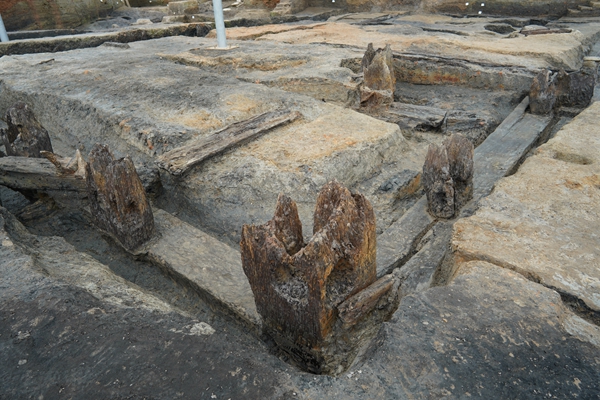

A prehistoric mansion
Guo says among a group of excavated wooden structures is F63(referring to "No 63 house ruins"), the largest and most well-preserved prehistoric edifice of its type discovered in Chinese archaeology.
The 4,700-year-old house has a floor area of 420 sq m, with an extra 210 sq m of corridors. F63 was made of nanmu and camphor trees, which are resilient to warping and cracking.
Before the construction of the building, planks were placed on foundation trenches and columns, 55 cm in diameter, were installed.
He says that, even without metal tools, using just implements made from stone and wood, the people of that time were able to produce smooth wooden planks between five and eight meters long.
"It's unlikely a house for daily living. It's more likely to be a place for a ritual or large public activities, revealing that Jijiaocheng was a hierarchical society," he says.
A team, led by Xu Yitao, a professor from the School of Archaeology and Museology of Peking University, simulated four different versions of how F63 might have looked, based on the discoveries of the foundations and upright columns, and their research on pile dwellings.
As Guangming Daily reported, Lin Liugen, a professor at the School of Art and Archaeology of Zhejiang University, said that "the discovery of F63 was unprecedented in Chinese archaeology history".
He concludes that the society of the time had an efficient management of labor, manual work and resources.
Guo says: "We're lucky to discover such important remains at the beginning of Jijiaocheng's archaeology work." He adds that work will continue for some time.
He looks forward to further discoveries that will uncover more facts about the site and those who lived there. For example, large-scale tombs and organic material, which could possibly be found in the moat, could shed further light on the history of the site. Experts are particularly curious about the site's layout, such as locations of residences and workshops.
Cao Yi, deputy head of Lixian county's culture, tourism, radio, television and sports bureau, says that further research will be done on a network of about 50 historical sites within 10 square kilometers around Jijiaocheng, to figure out their relationship.